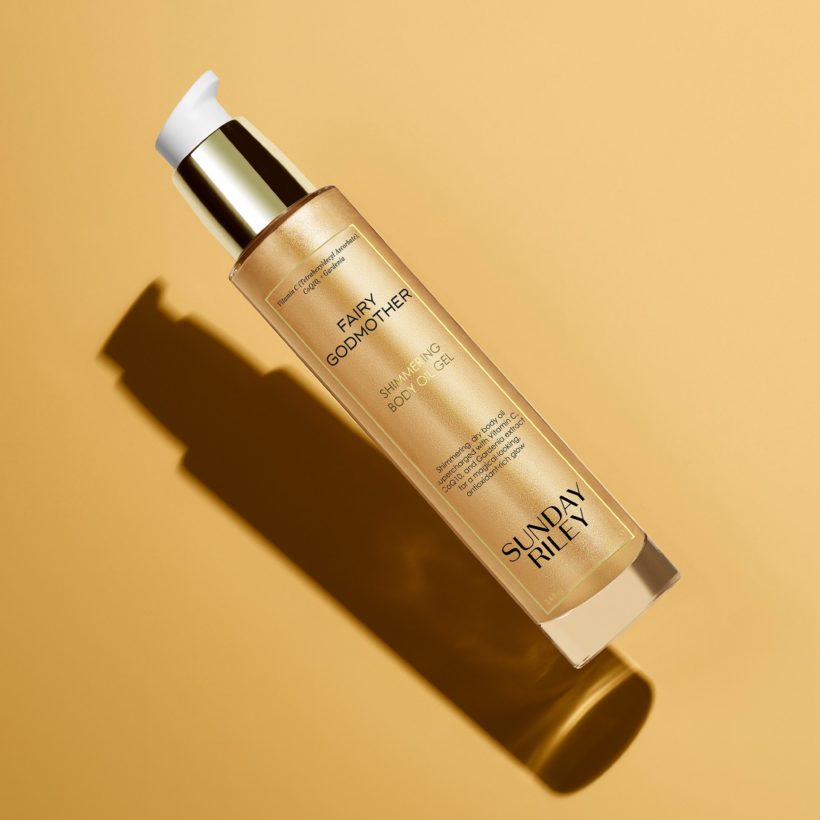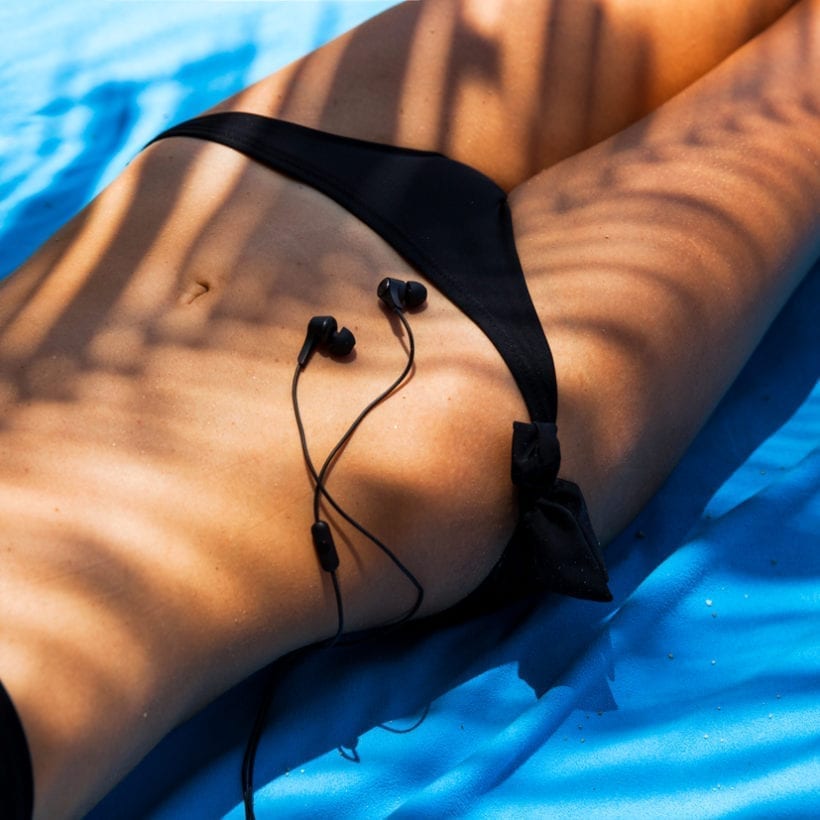When I think back on my teenage days of applying oil (like literal baby oil) and laying out by the pool all day, I cringe. We all know by now (at least I hope we do) that prolonged exposure to the sun can cause skin cancer and is a leading cause of premature aging (like wrinkles or sagging skin) but I won’t deny that I love a good glowy, even tan.
This is why — in my adult, sun-hat, SPF-slathering life — I’ve turned to get an occasional spray tan to recreate that sun-kissed look, sans sun. But as I’ve started to pay more attention to what I put in and on my body, I started to consider if spray tans were actually safe. So, I asked two dermatologists and the owner of an organic tanning salon for the scoop.
How Does A Spray Tan Work?
A lot of people think that the liquid that gets sprayed on your body during a spray tan is tinted, causing the skin to look tanner, but that’s actually not totally true (though some tanners do contain a bronzer so the artist can see what they’re doing). “Most spray tan solutions are clear with variations of topical bronzer added that help to guide the artist with the solution application. The bronzer is what you see rinsing off in your first shower post spray tan,” Brittani Zonker, owner of Bronzed by Britt says.
But the active ingredient in spray tans is a chemical called DHA or dihydroxyacetone, which causes a chemical reaction of the skin.
“DHA is a simple sugar which, when applied to the skin, leads to a chemical reaction involving the uppermost part of the skin known as the stratum corneum,” Dr.Sandy Skotnicki, dermatologist and author of Beyond Soap says. “DHA interacts with amino acids of the keratinocyte cells leading to a darkening effect. I like to explain to patients that it is similar to the caramelization of onions — when you cook them they darken. It’s a simple chemical reaction.” Dr. Skotnicki adds that DHA only affects the uppermost skin cells which will be sloughed off, so spray tans are generally considered safe. However, there’s a bit of a caveat here you may want to take note of (spoiler alert: keep your eyes and mouths tightly closed during a spray tan).
Are Spray Tans Safe?
DHA is an FDA-approved chemical and has been used in sunless tanning products since the ‘70s. The catch is that the approval of the ingredient is restricted to the external application. A statement from the FDA says, “the industry has not provided safety data to FDA in order for the agency to consider approving it for use on… ‘misting’ from tanning booths,” so, simply put, DHA in spray tans is not technically FDA-approved.
If you’re pregnant or nursing, it’s probably best to skip the spray tan and opt for a shimmering body oil instead.
“It should not be inhaled or applied to mucous membranes,” NYC dermatologist, Dr. Hadley King says. “Many feel that there is unlikely to be a risk to casual users, but the safety of the products has not been tested. The lungs have a huge surface area, so this compound gets into cells and gets absorbed into the bloodstream. There is also the possibility that dihydroxyacetone could make problems like chronic obstructive pulmonary disorder (COPD) worse,” Dr. King adds that there is a risk of damaged DNA from inhalation. If you’re pregnant or nursing, it’s probably best to skip the spray tan and opt for a shimmering body oil instead.
If you are still planning to get a spray tan, be sure to protect your body’s mucus membranes, which includes wearing protective eyewear, and maybe even wearing a mask (this gets tricky as you don’t want a mask tan — though I will say I accidentally forgot to take my mask off the last time I got a spray tan, and it wasn’t noticeable at all). You could also consider wearing a thick coat of lip balm to protect your lips, and of course, try not to inhale during the spray process.
Is A Spray Tan Safer Than Laying Out In The Sun?
When you consider the risks of both spray tanning and sun exposure, spray tans are the safe option (especially if you’re — gasp — not wearing SPF outside).
“[Spray tanning] needs to be done in a safe manner, avoiding inhalation. UV rays are a proven carcinogen, and are the most significant extrinsic factor in skin aging,” Dr. King says. UV rays are present in tanning beds, and a spray tan is also a better option than a bed.
However, it’s important to remember that self-tanners (either in the form of lotions, mousses, tan towels, gels, or spray tans) do not protect your skin from the sun, and they do not act as “base tan” (an idea that has been largely debunked as all darkening from the skin as a result of the sun indicates some level of DNA damage).
“A regular tan holds about an SPF of 3-5,” Dr. Skotnicki says. “This is because UVL stimulates melanocytes and when the pigment is deposited in the upper layers of the skin it helps protect you. The staining of the skin with DHA does not offer sun protection.”
The best option to fake a tan is to use a self-tanning lotion (as opposed to a spray tan), where there is zero risk of inhalation. “There is no UV damage when using a DHA self-tanner, ” Dr. Skotnicki explains. A self-tanner that comes in a spray bottle is likely safe to use carefully, but you should avoid aerosols.
“Look for self-tanners that are oil-free and non-comedogenic,” Dr. King says. “Some self-tanners include ingredients like glycolic acid or lactic acid to gently exfoliate the skin and help minimize the risk of clogged pores.”
To add a little bronzy glow that’s full of nourishing ingredients, you could try Fairy Godmother Shimmering Body Oil Gel.
How Do I Prepare For A Spray Tan?
As noted, there are some studies that show the potential for DHA inhalation to alter DNA, but more studies are needed. If you decide the potential risks are worth the reward of glowy, tan skin (no sun required) here’s the best way to prepare for a spray tan, plus aftercare tips to get the most out of your tan.
- “Skin prep is one of the most important steps in the spray tanning process. The number one pre-tan step is: exfoliation,” Zonker says, It’s best to exfoliate 12-24 hours prior to your tanning session, and Zonker adds it’s actually best to exfoliate twice and use a spray tan removal mitt. These mitts are also good to have on-hand (literally) if you have a little sunless tanner mistake and need to remove your streaky tan ASAP (I’ve been there).
- Shave after you exfoliate, ideally a day before your appointment to give the hair follicles time to close. “Any waxing must be done 48 hours prior to your appointment and never after a spray tan,” she says. And if you’re going all out (maybe before a vacation or a special event) it’s best to get a manicure and pedicure at least a day before your scheduled tan to give lotions and oils time to rinse off. If post-tan is your only option, Zonker says you should ask for a dry mani and pedi, “as your tan may become uneven due to soaking, acetone, oils, lotions.”
- Skip any moisturizer, deodorant, makeup and perfume the day of your spray tan appointment, and try to wear loose, dark clothing and flip flops or shoes that don’t fully cover your feet.
As for aftercare, avoid touching your skin as much as possible, try to take quick showers without using exfoliators (like a loofah) and be mindful of animal licks from your furry pals (I know, bummer) which can lift the color or make it appear patchy. Zonker says to keep your skin hydrated with a moisturizer that doesn’t include mineral oil or fragrance, and if you’d like, you can start using a tan extender on day four of your spray tan.
So while the risks of spray tans need more research, it’s definitely a better idea than baking out in the sun.
We only recommend products we have independently researched, tested, and loved. If you purchase a product found through our links, Sunday Edit may earn an affiliate commission.








